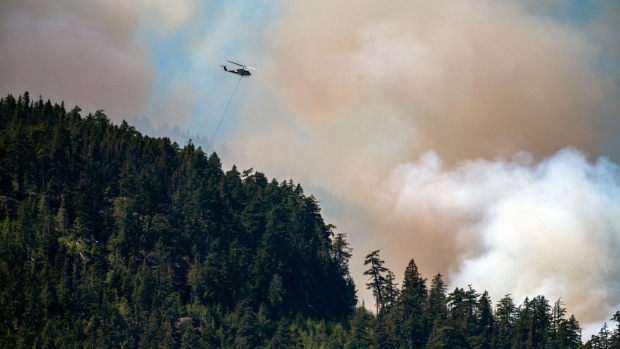Jun 8, 2023
Heat and Dryness From Climate Change Is Making Wildfires Much Worse
, Bloomberg News

(Bloomberg) -- Hotter, drier conditions brought about by greenhouse gas pollution make wildfires like those burning in Quebec more common in forests throughout the planet’s temperate zones.
An unseasonably hot spring this year primed trees, plants and soil for the extraordinary event that’s turned skies orange above New York City. Its scale calls to mind 2020’s Siberian fires: Human-caused climate change made the heat wave behind that event at least 600 times more likely.
“The fires that are burning in Quebec are the biggest fires in the world right now,” said Thomas Smith, an associate professor in environmental geography at the London School of Economics. “There’s one that I analyzed satellite imagery of. It’s about 100,000 hectares, 1,000 kilometers squared. There are very few fires that get to that size.”
Read More: The Hazardous Smoke Impacting Millions of North Americans
Smith is an environmental and fire scientist who specializes in wildfire behavior and climate emissions. He answered questions for Bloomberg Green about wildfires, their prevention and climate change.
Wildfires are normal but these seem not to be. Is there a link to climate change?
You’d expect to see a fire in a particular stand of forest every 100 to 130 years or so. What we’re seeing in other parts of the world with the boreal forests ecosystem, particularly in Siberia, is the frequency is increasing. It’s not just the Siberian fires. The [2019 to 2020] New South Wales fires had a World Weather Attribution study and that basically concluded that it would have been impossible without climate change; that that fire just simply could not have happened.
What’s concerning is this particular series of fires [in Canada] has happened very early in the year. The cumulative burn area is almost what you’d expect by the end of the fire season. Most of the fires usually happen in late July or August, early September. The reason why we’re seeing such large burn area at this time of the year is because of this heat wave — double digits in Celsius above the mean temperature for this time of the year.
If it’s warmer than usual, you’re going to have a faster fire, you’re going to have a more intense fire. The link between climate and fire behavior is important.
What are the long-term effects of an event like this?
Even if forests were to grow back, that carbon’s going to be in the atmosphere now for 30, 40, 50 years before it’s sequestered. And it’s these next few decades that are really important. You need to stop burning anything that releases CO2.
Read More: What Science Tells Us About the Dangers of Wildfire Smoke
About 30% to 50% of the soil is probably peat in this area. If it’s dry — this early it might not be dry yet, but it has been extremely hot — but if it is dry, then you will see the peat burning as well. That is like burning fossil fuels because the [carbon-rich] peat has taken hundreds of years to accumulate.
Can you explain the relationship between weather — temperature, relative humidity, wind speed — and how a fire behaves?
When temperature goes up, generally the relative humidity goes down. The reason for that is that warmer air can hold more moisture.
I’ve been looking at conspiracy theories about these Canadian fires in Quebec. People asking, why do they all flare up at the same time? The reason for that is the weather, the relative humidity. Overnight [when the temperature drops], the relative humidity goes higher. That calms the fire down, because of the moisture in the air.
But then as the temperature rises with the sunrise, the relative humidity goes down, and the fire flares up again because of that relationship between these weather variables and fire behavior. You start seeing much larger flames. With that, you see a lot more combustion of fuels, which is why you see the smoke plumes suddenly appearing in the morning and you don’t really see them at night.
It really, really annoyed me seeing these conspiracy theories. I was just like, “Well, it's just because the weather has changed and the sun has risen.”
How big a problem is forest management on top of the climate influence?
Land management and fuel management play a really important role here. I hate to say it, but even Trump was slightly right when he said that the California forest needed better management.
You’ve got the Western colonial powers, the old European powers, and they land in Australia. They cross to California. And they see this landscape and they think, “This is natural, and we need to conserve it.” And they remove all the people from the landscape, as if they’re not part of it. And what we now know is that Indigenous people in Australia and California and Canada played a very important part in managing what we thought of as natural areas.
You’ve got the mismanagement of the fuels on the ground and you’ve got the climate change. And that’s why we’re seeing some really devastating fires.
©2023 Bloomberg L.P.





